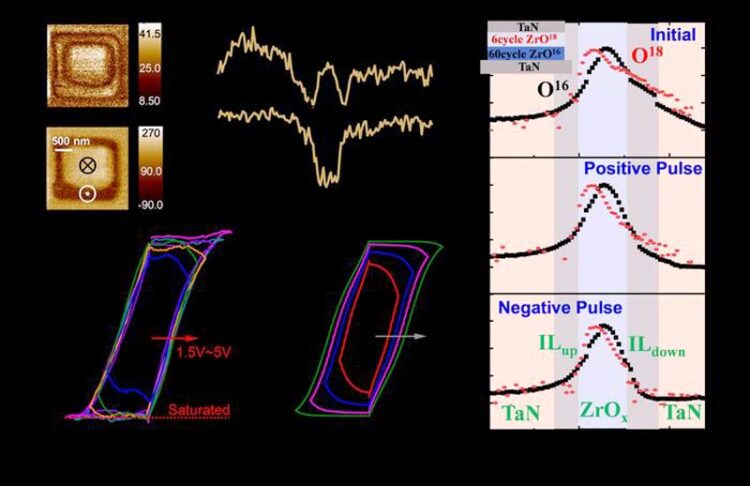Evidence for reversible oxygen ion movement during electrical pulsing

Evidence for the emerging ferroelectricity in binary oxides
Credit: Prof. Yan Liu from Xidian University
…enabler of the emerging ferroelectricity in binary oxides.
In a recent study published in Materials Futures, researchers have uncovered a pivotal mechanism driving the emergence of ferroelectricity in binary oxides. The study sheds light on the reversible movement of oxygen ions during electrical pulsing as a fun.
Ferroelectric binary oxides thin films are garnering attention for their superior compatibility over traditional perovskite-based ferroelectric materials. Its compatibility and scalability within the CMOS framework make it an ideal candidate for integrating ferroelectric devices into mainstream semiconductor components, including next-generation memory devices and various logic devices such as Ferroelectric Field-effect Transistor, and Negative Capacitance Field-effect Transistor. It has been reported that challenges remain in the widespread adoption of these materials, such as insufficient electrostatic control, compromised reliability, and serious variation for EOT scaling in terms of very large-scale integration. Recent research has elucidated ferroelectric-type behaviours in amorphous dielectric film. However, it is hard to clearly distinguish this observed hysteresis and ferroelectricity with classic ferroelectric films with conclusive contributions of specific phases. Therefore, it is imperative to note that the classification of amorphous materials as ferroelectric is subject to ongoing scientific debate.
The Solution: The physical mechanism for the ferroelectricity discussed by the authors involves the reversible movement of oxygen ions during electrical pulsing. This movement of oxygen ions is considered a key enabler for the emerging ferroelectric behavior observed in binary oxides. The authors suggest that this reversible oxygen ion movement plays a crucial role in inducing and controlling the ferroelectric properties of the materials.
The Result: Emerging ferroelectricity exists in the ultrathin oxide system due to microscopic ion migration in the switching process. These ferroelectric binary oxide films are governed by the interface-limited switching mechanism. Nonvolatile memory devices featuring ultrathin amorphous dielectrics reduced operating voltage to ±1 V.
The Future: Although a series of characterization tests and simulation analyses have been conducted, the understanding of the mechanism behind the emerging ferroelectricity in amorphous dielectric remains limited. To advance the application of this novel ferroelectric material, further research on the theoretical mechanism must be carried out.
Prof. Yan Liu, the lead author of the study, expressed optimism about the implications of their research: “ our work not only elucidates the mechanism behind the emergence of ferroelectricity in binary oxides but also pave the way for innovative advances in the semiconductor technology”. The advancement of innovative computing methods, such as neuromorphic computing, is closely tied to the development of novel devices and architectures. A primary area of emphasis is ferroelectric materials, which are essential for integration with existing CMOS technology. We demonstrate that ferroelectricity can be engineered in conventional amorphous high-κ dielectrics by simply adjusting the oxygen level during the low-temperature ALD deposition. The discovery of emerging ferroelectricity in amorphous binary oxides opens up a new path for non-volatile storage technology solutions, which can avoid the shortcomings of reliability degradation and gate leakage increment in scaling poly-crystalline doped HfO2-based films. Based on the amorphous dielectrics, a non-volatile memory device with low temperature process compatibility, low leakage current, excellent reliability and low operating voltage can be realized.”
The Impact: The presented approach expands the research subject of conventional ferroelectricity to engineer lots of widely used extremely thin binary oxide for logic or memory transistors for future CMOS technology!
The research has been recently published in the online edition of Materials Futures, a prominent international journal in the field of interdisciplinary materials science research.
Reference:
Huan Liu, Fei Yu, Bing Chen, Zheng-Dong Luo, Jiajia Chen, Yong Zhang, Ze Feng, Hong Dong, Xiao Yu, Yan Liu, Genquan Han and Yue Hao “Evidence for reversible oxygen ion movement during electrical pulsing: enabler of the emerging ferroelectricity in binary oxides.”
https://iopscience.iop.org/article/
Journal: Materials Futures
DOI: 10.1088/2752-5724/ad3bd5
Method of Research: Experimental study
Subject of Research: Not applicable
Article Title: Evidence for reversible oxygen ion movement during electrical pulsing: enabler of the emerging ferroelectricity in binary oxides
Article Publication Date: 12-Apr-2024
COI Statement: The authors declare no conflicts of interests
Media Contact
Yan He
Songshan Lake Materials Laboratory
heyan@sslab.org.cn
Original Source
All latest news from the category: Materials Sciences
Materials management deals with the research, development, manufacturing and processing of raw and industrial materials. Key aspects here are biological and medical issues, which play an increasingly important role in this field.
innovations-report offers in-depth articles related to the development and application of materials and the structure and properties of new materials.
Newest articles

First-of-its-kind study uses remote sensing to monitor plastic debris in rivers and lakes
Remote sensing creates a cost-effective solution to monitoring plastic pollution. A first-of-its-kind study from researchers at the University of Minnesota Twin Cities shows how remote sensing can help monitor and…

Laser-based artificial neuron mimics nerve cell functions at lightning speed
With a processing speed a billion times faster than nature, chip-based laser neuron could help advance AI tasks such as pattern recognition and sequence prediction. Researchers have developed a laser-based…

Optimising the processing of plastic waste
Just one look in the yellow bin reveals a colourful jumble of different types of plastic. However, the purer and more uniform plastic waste is, the easier it is to…



